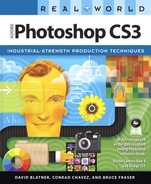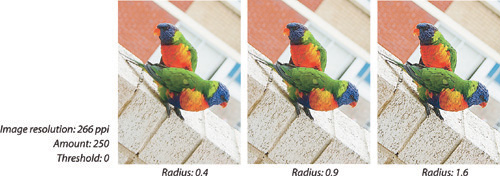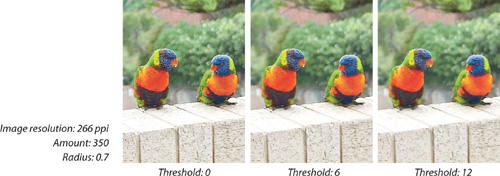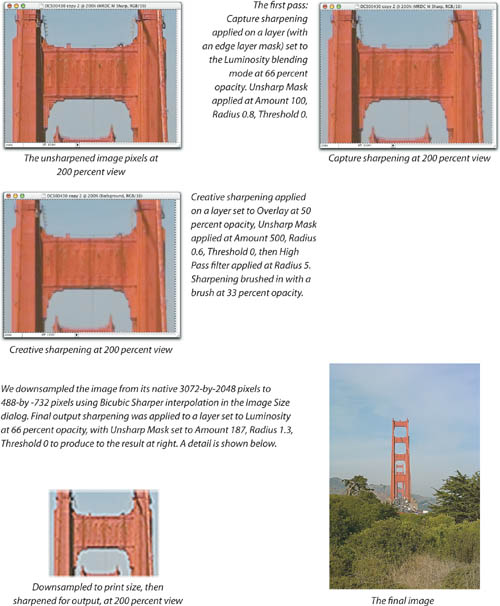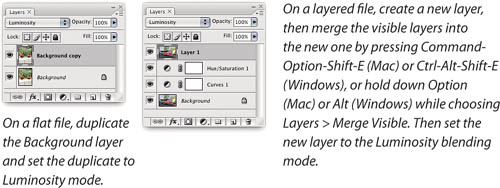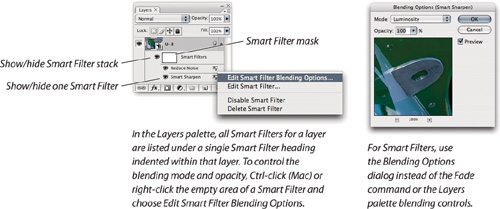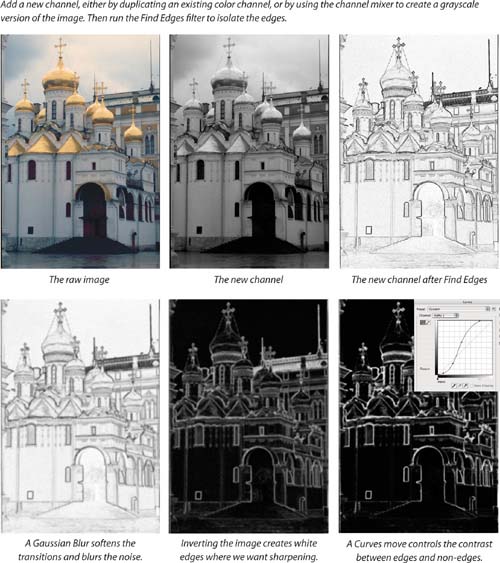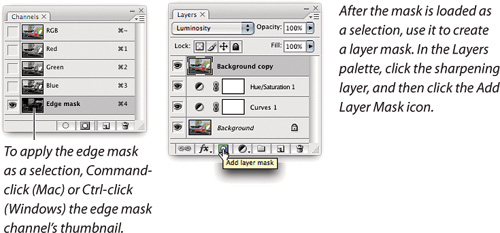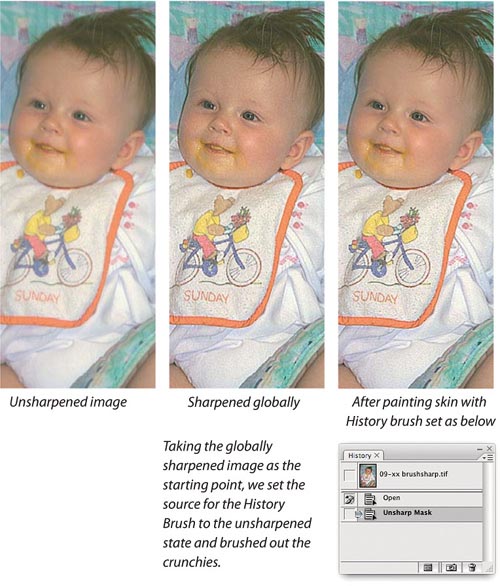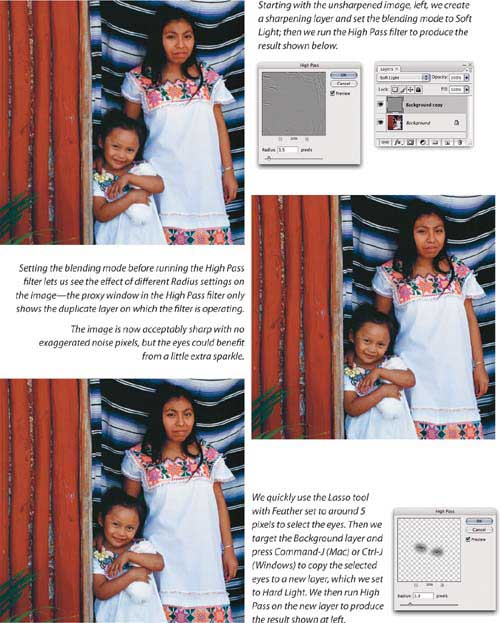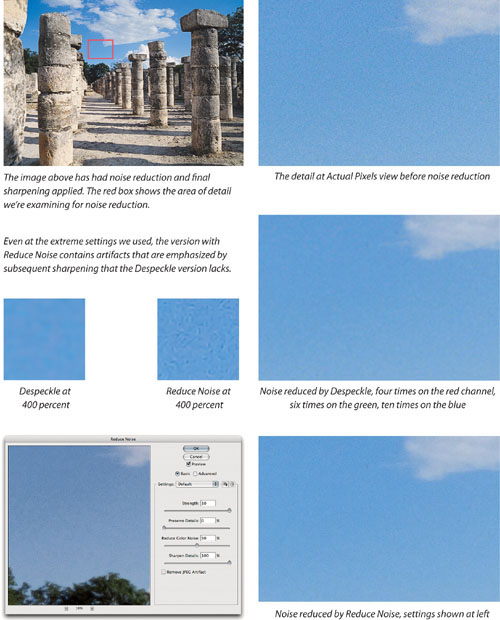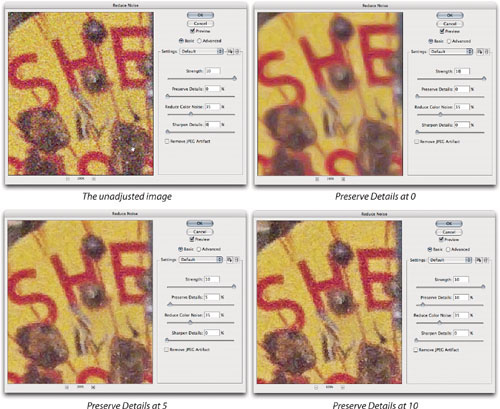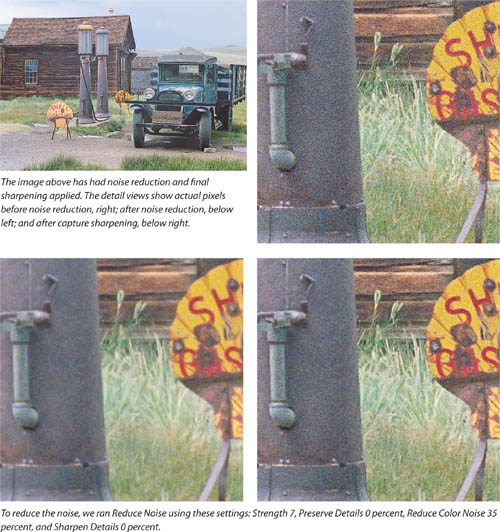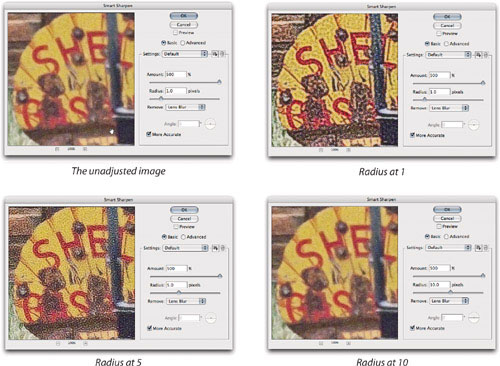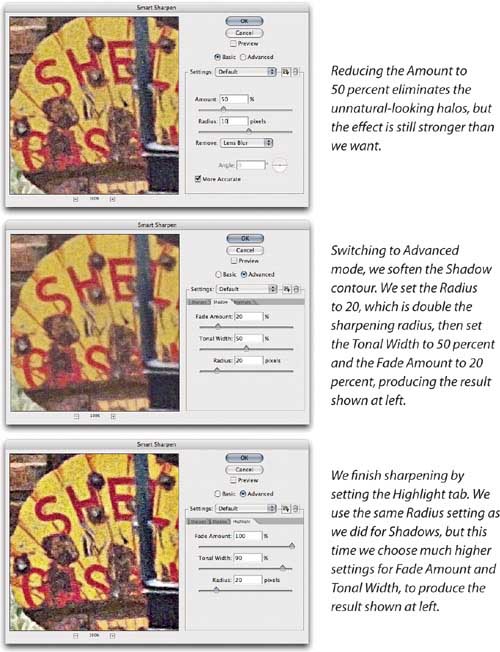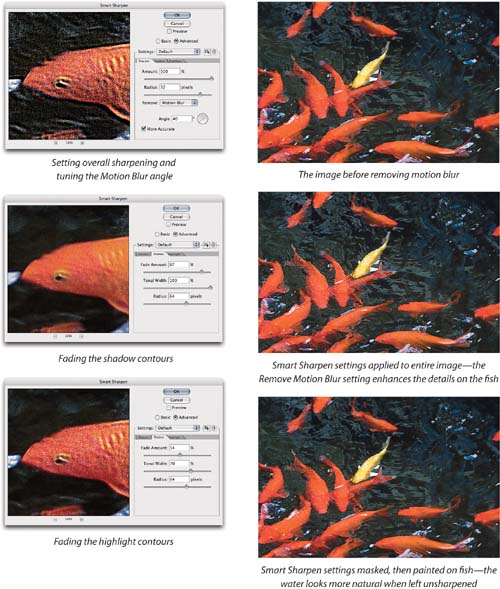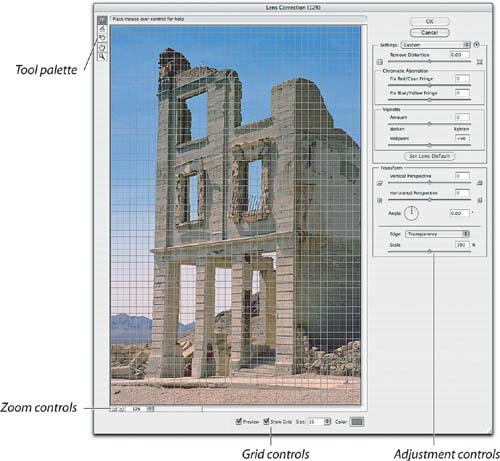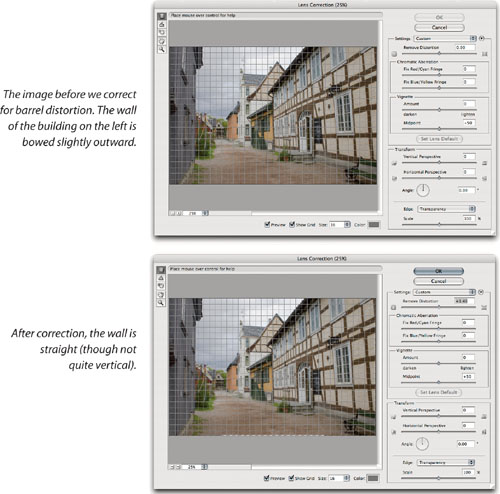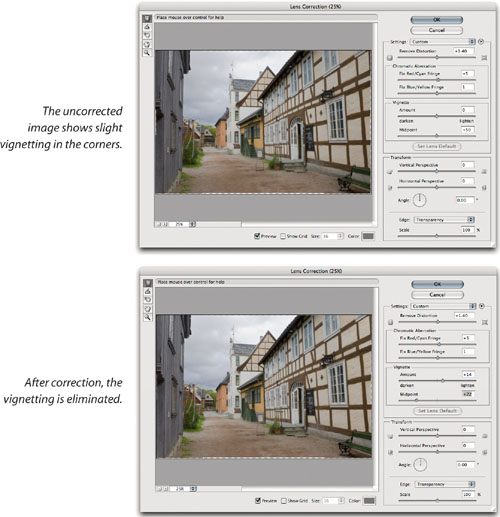The human visual system depends to a great degree on recognizing edges. Our eyes pass information to our brain, where every detail is quickly broken down into “edge” or “not edge.” (Thousands of years of evolution have developed our brains to ignore most of what’s going on in our field of vision and instead focus immediately on moving edges that might turn out to be a hungry tiger.) An image may have great contrast and color balance, but without good edge definition, we simply see it as less lifelike.
No matter how good your camera or scanner and how crisp your original may be, you always lose some sharpness when an image is digitized. Images from scanners and digital cameras always need a considerable amount of sharpening, though high-end scanners may sharpen as part of the scanning process. Even a high-resolution digital camera back mounted on a finely focused view camera produces images that will benefit from sharpening. You cannot solve the problem of blurry scans by scanning at a higher resolution. It just doesn’t work that way.
Your images also lose sharpness in the output process. Halftoned images (almost anything on a printing press) and dithered ones (such as those printed on inkjet or other desktop printers) are by far the worst offenders. But even continuous-tone devices such as film recorders and dye-sublimation printers lose a little sharpness.
In addition to detail, images contain noise—digital captures have camera noise, film scans have film grain that may be exacerbated by scanner noise. We only want to sharpen the detail, not the noise. However, because it’s hard for software to tell the difference between noise and detail, all noise-reduction solutions have to walk the fine line between increasing edge detail and decreasing noise.
In Photoshop itself, we generally apply noise-reduction techniques only on very noisy images—scans of color negatives and digital captures at ISO 800 and up are prime candidates. When working with digital raw captures, we often make use of the noise reduction in Adobe Camera Raw. Otherwise, we prefer to concentrate on sharpening the available detail but not the noisy areas, partly because we don’t want to soften the image unnecessarily with noise reduction, and partly to avoid another workflow step.
When we do perform noise reduction—either the Reduce Noise filter in Photoshop or a third-party plug-in such as Noise Ninja, Grain Surgery, or Neat Image—we always do so before sharpening, for the simple reason that it works better than doing so afterward (why sharpen noise?). We’ll cover noise reduction further later on in this chapter.
Lenses introduce their own quirks to the mix. Some lenses are simply sharper than others. (The Lens Blur mode in the Smart Sharpen filter specifically addresses lens softness.) A second lens problem, which we encounter a great deal more with digital capture than we did with film, is chromatic aberration, where the lens fails to deliver the red, green, and blue wavelengths to the same plane of focus, producing color fringing. It’s a particular problem towards the wide end of wide-angle zooms.
We suspect that we see chromatic aberration in digital capture more than in film simply because digital is much less forgiving to lenses. Film grain and interlayer scattering of the light tend to mask chromatic aberration where digital capture reveals it quite brutally—shooting film and digital with the same lens tend to bear this out. The Lens Correction filter can address chromatic aberration in Photoshop, but if you have a raw, JPEG, or TIFF file, you may prefer the slightly more interactive chromatic aberration correction controls in Adobe Camera Raw (see Chapter 5, “Building a Digital Workflow.”)
We’ll cover noise reduction and lens corrections in the course of this chapter, but while only some images need noise reduction or lens fixes, every image needs sharpening, so that’s where we’ll start.
To counteract the blurries in both the input and output stages, you need to sharpen your images. Photoshop offers several sharpening tools, but Unsharp Mask and Smart Sharpen are the only ones that really work as production tools. The Sharpening tool and the other sharpening filters may be useful for creative effects (and even then, we prefer other approaches), but they’ll wreck your images very quickly if you use them to compensate for softness introduced during either acquisition or output.
Smart Sharpen is a newer, more powerful sharpening filter than Unsharp Mask. However, if you want to understand sharpening, the place to start is the Unsharp Mask filter. It’s easier to understand and executes more quickly than Smart Sharpen.
Unsharp masking (often abbreviated as USM) may sound like the last thing you’d want to do if you’re trying to make an image appear sharper, but the term actually makes some sense; it has its origins in a traditional film-based technique for enhancing photographic sharpness.
The things we see as edges are areas of high contrast between adjacent pixels. The higher the contrast, the sharper the edges appear. So to increase sharpness, you need to increase the contrast along the edges.
In the traditional process, the photographic negative is sandwiched in the enlarger along with a slightly out-of-focus duplicate negative—an unsharp mask—and the exposure time for printing is approximately doubled. Because the unsharp mask is slightly out of focus and the exposure time has been increased, the light side of the edges prints lighter and the dark side of the edges prints darker, creating a “halo” around objects in the image (see Figure 10-1).
As you’ll see throughout this chapter, this halo effect is both the secret of good sharpening and its Achilles’ heel depending on the size and intensity of the halo and where it appears in the image. Photoshop lets you control the halo very precisely, but there’s no single magic setting that works for all images; so you need to know not only how the controls work, but also what you’re trying to achieve in the image.
The Unsharp Mask filter operates pixel by pixel, which explains why it can sometimes take so long. It compares each pixel to its neighbors, looking for a certain amount of contrast between adjacent pixels, which it assumes is an edge. It then increases the contrast between those pixels according to the parameters you set. This creates a halo that, at normal viewing distances, increases apparent sharpness.
But Photoshop can’t actually detect edges—it just looks at contrast differences (zeros and ones again). So unsharp masking can also have the undesired effect of exaggerating texture in flat areas and skin tones, and emphasizing any noise introduced by the scanner in the shadow areas.
You need to walk a fine line, sharpening only where your image needs it. The filter itself has few controls to adjust what gets sharpened (see Figure 10-2). So, we much prefer running sharpening through a mask. But to do so, you still need to understand the settings you can control in the Unsharp Mask filter, what they do, and how they interact.
We think of Amount as the volume control—it adjusts the intensity of the sharpening halo (see Figure 10-3). High Amount settings—you can enter up to 500 percent—produce intense halos with many pixels driven to pure white or solid black); low Amount settings produce less intense ones. Amount has no effect on the width of the halos—just on their contrast.
As you increase the Amount setting, the blips around big tonal shifts (edges) can be pushed all the way to white and black. At that point, increasing Amount has no effect—you can’t get more white than white! Worse, the all-white halos often stand out as artifacts and can look really dumb.
We almost always start out by setting Amount much higher than we’ll eventually want it—between 400 and 500—until we set the Radius. Then we adjust downward from there, depending on the image (see “Working the Controls,” later in this chapter).
Radius is the first thing to consider when sharpening; it sets the width of the halo the filter creates around edges (see Figure 10-4). The wider the halo, the more obvious the sharpening effect. Choosing the correct Radius value is probably the most important choice in avoiding an unnaturally oversharpened look, and there are several factors to take into account when you choose, starting with the content of the image itself, the output method, and the intended size of the reproduction (see the sidebar “Image Detail and Sharpening Radius,” later in this chapter).
Tip
If sharpening looks too strong after closing the Unsharp Mask dialog, choose Edit > Fade and lower the Opacity value (see “Filters and Effects” in Chapter 11, “Essential Image Techniques.”
Note that a Radius value of 1.0 does not result in a single-pixel radius. In fact, the halo is often between 4 and 6 pixels wide for the whole light and dark cycle—two or three pixels on each side of the tonal shift. However, it varies in width depending on the content of the image.
Unsharp Mask only evaluates contrast differences: it doesn’t know whether those differences represent real edges you want to sharpen or areas of texture (or, even worse, scanner noise) that you don’t want to sharpen. The Threshold control lets you specify how far apart two pixels’ tonal values have to be (on a scale of 0 to 255) before the filter affects them (see Figure 10-5). For example, if Threshold is set to 3, and two adjacent pixels have values of 122 and 124 (a difference of two), they’re unaffected.
Tip
If your computer is on the slow side, try turning off the Preview check box to avoid the time-consuming full-screen redraw of the preview. You can still use the preview inside the Unsharp Mask dialog to check the results. Remember, pressing the mouse button inside the dialog preview toggles between the before and after states.
You can use Threshold to make the filter ignore the relatively slight differences between pixels in smooth, low-contrast areas while still creating a halo around details that have high-contrast edges. And, to some extent at least, you can use it to avoid exaggerating noisy pixels in shadow areas.
Low Threshold values (0 to 4) result in a sharper-looking image overall (because fewer areas are excluded). High values (above 10) result in less sharpening, but often produce unnatural-looking transitions between the sharpened and unsharpened areas. We typically start out with a zero Threshold value, and then increase it only if necessary.
One of the most important concepts to understand about sharpening is that the three values you can set in the Unsharp Mask dialog are interrelated. For instance, as you increase the Radius setting, you generally need to decrease Amount to keep the apparent sharpness constant. Similarly, at higher Radius settings, you can use much higher Threshold values; this smooths out unwanted sharpening of fine texture while still applying a good deal of sharpness to well-defined edges.
When we’re trying to determine the right sharpening settings for an image, we start by setting the Radius. We usually start out with exaggerated Amount and Threshold settings (400 percent and 0), then we experiment with the Radius value. The exaggerated Amount and Threshold make it easy to see what’s happening as we adjust the Radius (see Figure 10-6).
As you increase the Radius, the apparent sharpness also increases—often to an undesirable extent. This is where the aesthetic considerations come in. Some people like more sharpening than others. We find highly sharpened images more disturbing than slightly soft ones, but that’s a matter of taste. It’s up to you to decide how much sharpening you want.
However much sharpening you decide to apply, you’ll find that as you increase the Radius setting, you need to decrease the Amount to keep the apparent sharpness constant. You can work these controls in opposition to achieve a wide range of sharpening effects.
Threshold is the third part of the equation. You can think of it as a selective smoothing function. At small (less than 1 pixel) Radius settings, a Threshold value as low as 15 or so will probably wipe out most of the sharpening effect. At higher Radius settings, you can use much higher Threshold values to smooth out unwanted sharpening of fine texture while still applying a good deal of sharpness to well-defined edges.
Tip
To start over with any filter, press Command-Z (Mac) or Ctrl-Z (Windows) to undo, then press Command-Option-F (Mac) or Ctrl-Alt-F (Windows) to reopen the filter dialog with the last-used settings.
There are dangers lurking here, though. As you use higher Amount and Threshold settings, you run an increased risk of driving pixels to solid black or solid white. The solid black ones aren’t usually too much of a problem, but the blown-out white ones can appear as noticeable artifacts, especially when they’re large due to higher Radius settings.
With higher Threshold settings, you get dramatic, unnatural sharpening of high-contrast edges while leaving smaller details soft. This makes the image look quite disturbing because it’s hard for the eye to reconcile the sharp edges and the soft detail. The image looks like there’s something wrong with the focus.
In short, the three parameters provided by Unsharp Mask give you a lot of control over the sharpening effect, but it takes a while to get your head around the way they interact.
If we got a nickel for each time we’d been asked what sharpening settings someone should use, we’d probably be sipping wine on a tropical island rather than writing books on Photoshop. Of course, we couldn’t really come up with a short answer any less lame than “it depends.”
The longer answer, of course, involves explaining the various factors on which it depends, which we’ll now proceed to do. First, a necessary disclaimer: PixelGenius, a company Bruce co-founded, publishes a sharpening plug-in called PhotoKit Sharpener. While we’d be pleased as punch if you considered purchasing PhotoKit Sharpener, you should know that a lot of what it does is based on the information in this chapter. The plug-in just does it a lot faster than you can do it manually.
Tip
For a deeper dive into the multistage sharpening workflow, pick up a copy of Bruce’s book Real World Image Sharpening in Photoshop CS2.
To understand how to sharpen, we first have to understand why we’re doing it at all. It turns out that there are basically three reasons why an image might need to be sharpened. Each of those reasons imposes its own demands, and often, these demands contradict one another. Fortunately, the reasons break down nicely into three stages that are easy to handle separately and in sequence during a production workflow.
Sharpening the capture. Whenever you turn photons into pixels, you lose some sharpness, because no matter how high the resolution of your capture devices, they sample a fixed grid of pixels, turning the continuous gradations of tone and color that exist in the real world into discrete pixels. Each capture device imposes its own noise pattern on the image, whether it’s from digital camera sensor noise or film grain.
You need to sharpen the image content to restore what was lost in the conversion to pixels, but you don’t want to also sharpen—and hence emphasize—the noise and grain. The goal of capture sharpening is to take into account the source of the image, compensating only for the amount of sharpness lost to a specific digital camera or scanner sensor.
Sharpening the image content. People often sharpen for creative reasons: to tell a story, to make a point, to emphasize an area of interest, or to sell a product. To do this successfully, you need to match your sharpening to the content of the image. A busy, high-frequency image with lots of tiny details, like a forest full of trees, has much narrower edges than a close subject with soft detail, like a head shot or a pumpkin (see Figure 10-7).
When sharpening image content, you want to emphasize the edges without overemphasizing textures—like skin tones—and without introducing spurious texture into flat areas, like skies. The point of creative sharpening is to take the image content into account, reproducing its details as effectively as possible.
Tip
If noise reduction is required, we’ll do it before sharpening, by running the Despeckle filter through a mask, running Reduce Noise on its own merged layer, or if it’s a digital camera raw file, we may employ the noise reduction in Adobe Camera Raw 4.1 or Lightroom. When extreme noise reduction is required, we’ll apply a mask to the noise reduction layer to protect the edges.
Sharpening the output. When you print, you lose sharpness again. In most cases, individual pixels aren’t translated into individual dots of ink or dye, and even in those cases where they are (such as when printing to photographic printers like the Durst Lambda or Fujifilm Pictrography) the printed “pixels” tend to be round rather than square. In either case, the output loses some sharpness. Because you want to make the print as sharp as the output device can render it, effective sharpening must take into account the output process.
The chances are exceedingly slim that you can satisfy all these different sharpening criteria with a single round of Unsharp Mask applied globally to the image. Of course, if one pass of Unsharp Mask is all you have time for in your workflow, it’s better than not sharpening at all. But for the highest quality (and flexibility when an image is expected to be repurposed), we recommend using a two- or three-stage approach to sharpening which we’ll lay out soon. Rather than try to satisfy all the criteria simultaneously, this workflow approach to sharpening addresses them separately.
Of course, if approached carelessly, this workflow can create ugly images. Just hitting the image with three rounds of Unsharp Mask using different radii is a recipe for certain disaster. Instead, retaining optimum quality requires finesse and some fairly advanced sharpening techniques.
We’ll admit that taking a workflow approach to sharpening is a fairly radical idea, but the more we use it, the more we find that it makes sense. We’ve done a great deal of testing—Bruce reckoned that he sharpened about 5000 images to build and fine-tune PhotoKit Sharpener—but plenty of work remains to be done. We look at individual sharpening techniques in detail later in this chapter, but here’s the 30,000-foot overview.
Our first sharpening pass aims to compensate for the shortcomings of the capture in a way that’s sensitive to the image content. We create a sharpening layer, apply an edge mask, sharpen with a radius that matches the image content, then constrain the tonal range to the midtones using the Blend If sliders in the Layer Style dialog. We use the edge mask so that only the high-contrast edges get sharpened. We use the Blend If sliders to focus the sharpening on the midtones, protecting highlights and shadows so that they don’t get driven to solid black and solid white.
With very grainy or noisy originals such as high-ISO digital capture or fast color negative, you may first want to apply some noise reduction using the Reduce Noise filter or a third-party noise reduction plug-in. If you’re working with raw digital camera files, you can use the sharpening sliders in Adobe Camera Raw 4.1 or Lightroom 1.1—their sharpening features were specifically designed for the capture sharpening stage, so that you only need to use Photoshop for creative and output sharpening.
This first round of sharpening must be done very gently indeed; otherwise the result is likely to be a hideously oversharpened mess. Remember, it’s only the first stage of sharpening, where you essentially perfect the capture. Don’t try to solve all of an image’s sharpening issues at this stage, because all you need to do here is set a solid baseline of overall sharpness that you’ll build on during the next two stages.
In the creative sharpening pass, we concentrate on the sharpening needs of the image content itself. If we find ourselves wanting to apply different amounts of sharpening to various parts of an image, this is the time to do it. We apply creative sharpening after we’ve fine-tuned the tone and color both globally and locally, because changes to contrast and color can easily affect the perceived sharpness.
For creative sharpening, you can build “sharpening brushes” to paint your sharpening just where you want it, such as the eyes of a portrait. One way to do this is to create a new merged layer, setting the layer’s blending mode to Luminosity (to avoid color-fringing), applying a global Unsharp Mask to the layer, then adding a layer mask set to Hide All. As you paint on the layer mask, Photoshop adds or removes the sharpening.
Creative sharpening effects are really only limited by your imagination. For example, one way to make an object appear sharper is to blur its surroundings—you can create “smoothing brushes” using the same techniques as sharpening brushes, but substituting a blur for the sharpen.
After capture and creative sharpening, we end up with an idealized image—corrected and enhanced as far as possible without being shackled to one specific purpose, size, or output device. You can still repurpose it (our mothers always taught us to keep our options open as long as possible), and responds well to resizing and final output sharpening.
Since the image-specific and source-specific concerns were already addressed in the capture and creative sharpening phases, output sharpening can concentrate solely on the requirements of the output process.
We apply output sharpening globally, by using a sharpening layer with no layer mask. For halftone and inkjet outputs, we often use the Hard Light/High Pass sharpening technique. Output sharpening must be done at final output resolution. If you think it’s likely the image will be resized after it leaves your hands, we advise omitting the output sharpening step; anyone who resizes the image will probably resharpen it anyway, and if you’ve done a reasonably good job in the capture and creative phases, the final result will still be sharp.
Tip
To keep output-specific edits, such as output sharpening, from accidentally being saved with your layered master image, choose Image > Duplicate (with the Duplicate Merged Layers Only option enabled) to create a flattened duplicate document. You can then apply output-specific optimizations to the copy, such as the appropriate sharpening settings for the printer you’re about to use.
The key difference between output sharpening and the earlier phases is that more often than not we produce a result that looks downright scary on the monitor. Keep in mind the physical size of the sharpening halo on output. Light and dark contours that are 3 pixels wide may look hideous on the monitor; but if you’re printing at 300 ppi, they’ll translate into contours (light and dark parts of the sharpening halo) that are only ![]() of an inch wide, so they won’t be obvious on the final print.
of an inch wide, so they won’t be obvious on the final print.
Note that you can only sharpen the image’s pixels—Photoshop has no control over how those pixels are rendered to ink on paper (or any other output process). So the key factor in output sharpening is the relationship between the pixels and the resulting hard copy. Hence output sharpening must be done at the final size and resolution, often as the last step before converting an RGB file to CMYK and saving the file to disk. Note that unlike capture and creative sharpening, output sharpening is something we always apply globally. Here are a few other considerations:
A rule of thumb that has served us well is to aim for a sharpening halo of approximately
 - to
- to  -inch (0.5 to 0.25 mm) in width, the thinking being that at normal viewing distances, a halo this size falls below the threshold of human visual acuity, so you don’t see the halo as a separate feature, you just get the illusion of sharpness that it produces.
-inch (0.5 to 0.25 mm) in width, the thinking being that at normal viewing distances, a halo this size falls below the threshold of human visual acuity, so you don’t see the halo as a separate feature, you just get the illusion of sharpness that it produces.For output sharpening, a good starting point for the Unsharp Mask filter’s Radius setting is image resolution ÷ 200. (Remember: we’re talking about final image resolution, after it has been placed on a page and scaled to fit.) Thus, for a 300-ppi image, you’d use a Radius of 1.5 (300 ÷ 200). For a 200-ppi image, you’d use a Radius setting of 1. This is a suggested starting point, not gospel. As you gain experience, you’ll find situations where the rule has to be bent. When sharpening using methods that don’t involve Unsharp Mask, you’ll have to look closely and do some math yourself.
On very large prints, you may have to use a slightly larger sharpening halo—if the resolution is less than 100 ppi, the halo will be larger than
 -inch because it takes at least two pixels (one light, one dark) to create the halo. But large prints are generally viewed from further away, so the longer viewing distance tends to compensate for the larger halo.
-inch because it takes at least two pixels (one light, one dark) to create the halo. But large prints are generally viewed from further away, so the longer viewing distance tends to compensate for the larger halo.Of course, there’s really no way to get an accurate onscreen representation of how a sharpened halftone output will look—the continuous-tone monitor display is simply too different from the halftone. An image well-sharpened for halftone output will typically look “crunchy” on screen. And the monitor resolution and view percentage can help or hinder your appraisal of an image’s sharpness. See the sidebar “Sharpening and the Display” for more on the subject.
Attempting to show the apparent onscreen sharpness in print is a very uncertain endeavor. What we’ve attempted to do in Figure 10-8 is to show the image pixels at 200 percent through the various phases of sharpening, along with the final printed image at print size, in the hope that doing so will give you some idea of the relationship between what happens to the pixels themselves and the influence on the final printed result.
Obviously, the onscreen appearance at Actual Pixels view will vary dramatically over different display types and resolutions, but as you zoom in, the differences between display types become much less significant. We hope that the figure at least demonstrates the dramatic differences in halos created by the capture and creative sharpening phases, and those created by the final output sharpening. To help understand what you’re seeing, we’ve also noted the sharpening settings we used for each step of the sharpening process, from capture to final output.
Output sharpening is the only phase that easily lends itself to a formula, because once the image has been sized and the output process chosen, the physical size of the pixels, and hence of the sharpening halos, is a known quantity. For the capture and creative phases of the sharpening workflow, common sense, good taste, and in the long run, experience are the best guides! The techniques that follow are ones that we use every day in our sharpening workflow, and as we describe them, we’ll tell you how we use them. But we don’t claim to have solved every conceivable sharpening problem, so feel free to pick and choose, and to adapt them to your own work.
We use a host of techniques in the sharpening workflow—some obvious, others less so. Some attempt to avoid accentuating dust and scratches, noise, and film grain by sharpening through a mask. Others seek to make sharpening nondestructive and editable after the fact by applying the sharpening on a layer, and still others use localized sharpening applied with a brush to pick out specific details in the image. In practice, we often mix these techniques into a single sharpening move, and we’ll provide some examples. However, it’s easier to digest the various techniques separately, so that’s how we’ll present them.
Tip
Some people like to sharpen images by converting them to Lab and sharpening only the Lightness channel. You can get an almost identical result by sharpening the RGB file, then choosing Edit > Fade, and set the Mode to Luminosity. It’s faster, and you don’t lose layers through a mode change.
We prefer to do most of our sharpening on layers, for much the same reasons we prefer using adjustment layers to burning Curves or Levels directly into an image—it’s nondestructive, it affords us control after the fact, and it allows us to use masking when we need to. In the first stage of the sharpening workflow, layer-based sharpening also provides an easy way to concentrate the sharpening in the midtones through the Blend If sliders in the Layer Options dialog.
Figure 10-9 shows the steps for creating a sharpening layer on a flat file or on a layered one. The layer is set to Luminosity mode to avoid any color shifts or color fringes—it produces essentially the same result as converting the image to Lab and sharpening the Lightness channel. You can then run the Unsharp Mask filter globally on the layer or apply Unsharp Mask through an edge mask.
Photoshop CS3 brings a new way to keep sharpening separate from the original layer: Smart Filters, which extend the Smart Object feature that first appeared in Photoshop CS2. With Smart Filters, you enjoy a freedom of choice with filters that’s similar to what you have with adjustment layers. Unlike Undo steps and the Fade command, you can edit the settings of a Smart Filter at any time without altering the original layer, even after you close and reopen a document.
Tip
A stack of Smart Filters can have only one mask for all of the filters in the stack. If you need to use a separate mask for each filter, you may have to stick with duplicating the image layer.
You can apply a filter as a Smart Filter only to a Smart Object; if you’re working with a file from Adobe Camera Raw that you opened as an object, you’re ready to go. With any other layer, you must first select the layer and choose Filter > Convert for Smart Filters (which is actually the same as choosing Layer > Smart Object > Convert to Smart Object). As long as a layer is a Smart Object, applying any available filter from the Filter menu creates a Smart Filter, shown in the Layers palette under a Smart Filters heading indented under the layer that uses them (see Figure 10-10). Not all filters are available as Smart Filters, but many of our favorite production filters are, including Unsharp Mask and Smart Sharpen. To edit a Smart Filter, just double-click it in the Layers palette.
Tip
When evaluating what a layer looks like with Smart Filters off, avoid hiding or showing individual Smart Filters whenever possible, because it forces Photoshop to re-render the entire filter stack. It’s dramatically faster to click the eye icon next to a layer’s Smart Filters heading in the Layers palette, which hides and shows all Smart Filters, because then all Photoshop has to do is hide or show the cached image for the entire layer stack.
One subtle aspect of Smart Filters you need to get is how to fade them. You can’t use the Layers palette blending mode or Opacity controls to edit a Smart Filter independently of its layer or the layer’s other Smart Filters, and the Edit > Fade command isn’t available either. What do you do? Ctrl-click (Mac) or right-click the Smart Filter thumbnail and choose Edit Smart Filter Blending Options, where you see a Mode pop-up menu, an Opacity value, and a preview (see Figure 10-10).
Given the ways that Smart Filters preserve your options indefinitely, it sure sounds like Smart Filters could be editing nirvana. Unfortunately, it isn’t. Smart Filters suffer from the same gotchas that afflict Smart Objects: They place huge demands on the CPU and on disk space, slowing down operations and creating very large files. For this reason, Conrad sometimes talks about Smart Objects as “editing with credit cards.” That is, Smart Objects give you a lot of very desirable power and flexibility, but overusing them can create an ongoing burden that can cost more than you expected.
We ran a quick test to see whether Unsharp Mask applied to a duplicate layer would take up more or less disk space than Unsharp Mask applied to the original layer as a Smart Filter. We found that a 13.7 MB TIFF file became a 36.2MB TIFF file after duplicating the original layer, running Unsharp Mask on the duplicate layer, and creating and painting on a layer mask for the duplicate layer. We took an unaltered copy of the original file and applied the same filter settings and mask, but this time as a Smart Filter, and ended up with a file size of 49.8 MB. The difference in RAM usage was similarly dramatic.
The trade-off is clear. If you’ve got the CPU, the RAM, and the disk space, Smart Filters can totally revolutionize your workflow, but on a machine with mediocre performance or limited available disk space, the old-school techniques will help preserve your sanity.
Edge masks are an indispensable tool for both sharpening and noise reduction. When sharpening, we use an edge mask to concentrate the effects of the sharpen on the edges, so that flat areas such as skies, and textured areas such as skin tones, don’t get oversharpened. For noise reduction, we use the same kind of mask, but inverted, so that the edges are protected from the noise reduction.
Figure 10-11 shows the steps for building an edge mask. The first step is to create a channel that has good contrast between the edges and the non-edges. Sometimes one of the existing color channels will work—simply duplicate the channel to serve as the basis for the edge mask—but often you can achieve better results by using Channel Mixer or Calculations to create the channel. See “The Color of Grayscale” in Chapter 11, “Essential Image Techniques,” for a slew of methods for creating a grayscale version of an image.
Once you have a grayscale version of the image, run the Find Edges filter to locate the edges, then use a combination of blurring and contrast adjustments to control the relationship of the edges and non-edges. Once you’ve created the edge mask, you can load it as a selection through which you apply the sharpening, or you can add it to the sharpening layer as a layer mask. Each approach has advantages and disadvantages.
Edge mask as selection. To load the edge mask as a selection, Command-click (Mac) or Ctrl-click (Windows) on the channel’s thumbnail in the Channels palette. We suggest hiding the selection’s marching ants by pressing Command-H (Mac) or Ctrl-H (Windows), the shortcut for the View > Extras command. Then, with the sharpening layer targeted, you can run Unsharp Mask. The white areas in the edge mask get fully sharpened, the black areas are fully protected from sharpening, and the gray areas receive sharpening proportional to the gray value.
The disadvantage is that you have no control over the transition between sharpened and unsharpened areas once you’ve applied the sharpening.
Edge mask as layer mask. Instead of sharpening through the mask as a selection, you can sharpen the layer globally, then add the edge mask as a layer mask: Load the edge mask as a selection, target the sharpening layer, and then click the Add Layer Mask icon in the layers palette (see Chapter 9, “Making Selections”).
Once you’ve added the layer mask, you can tweak the contrast of the layer mask with Levels or Curves to fine-tune the relationship between the sharpened and unsharpened areas. The downside to using the edge mask as a layer mask (rather than just sharpening the selection) is simply that it creates a larger file. Figure 10-12 shows the steps for applying the edge mask as a selection or as a layer mask.
Edge mask for noise reduction. You can use approximately the same edge-masking technique to apply noise reduction instead of sharpening. Invert the mask (or omit the inverting step when creating the mask), leaving the edges black (so that they’re protected from the noise reduction), and the non-edges white (so that they receive the full benefit of noise reduction). It’s usually a good idea to use a slightly different blur, as well as different contrast, on the noise mask than on the edge mask—if you simply invert them, you can exaggerate the transition between the edges and non-edges in both the noise reduction and sharpening layers. Making the masks slightly different helps a great deal.
We find that the Despeckle filter does a great job of minimizing film grain and digital noise, but we generally apply it separately to each color channel, because typically one channel will need more applications than another. With film or print scans, the blue channel is almost invariably the noisiest, so we may run Despeckle once on the red channel, twice on the green channel, and three or more times on the blue channel. On digital images captured as JPEG, we look at each channel to determine where the noise lies and Despeckle accordingly. With digital raw images, unless they’re extremely noisy, we rely on the noise-reduction features in Camera Raw. Note that in Adobe Camera Raw 4.1, the Mask slider in the Detail tab creates an edge mask for the image; see “The Detail Tab” in Chapter 5, “Building a Digital Workflow.”
If the noise is primarily in luminosity, as it is with transparency film, we prefer to carry out noise reduction on a layer that’s set to Luminosity blending. Using separate layers for sharpening and noise reduction offers more control, but at the cost of a larger file size.
We also use masks with the new Reduce Noise filter, especially on higher-resolution film scans, where the filter seems to want to preserve the grain as well as the detail. The ability to edit the layer mask adds a level of post-filtering control that we often find useful.
One of the keys to a successful multipass sharpening workflow is to concentrate the first round of sharpening on the midtones while protecting the extreme highlights and shadows. It’s so much easier to do this using a sharpening layer that we don’t even try to use a nonlayered sharpen. The trick to controlling the tonal range is to use the Blend If sliders in the Layer Style dialog—choose Layer > Layer Style > Blending Options, or double-click the layer’s thumbnail in the Layers palette (see Figure 10-13).
The Blend If sliders let you control which tonal values in the overlying (sharpening) layer get applied to the underlying layer (and, conversely, which tonal values in the underlying, unsharpened layers are affected by the sharpening layer). Bruce talked about the overlying layer as a ton of bricks suspended over a basket of eggs (the underlying layers). The top Blend If slider controls which bricks fall, and the bottom Blend If slider dictates which eggs receive the impact.
Figure 10-13 shows some typical settings for the Blend If sliders for initial midtone sharpening. Depending on the image source (film or digital) and the amount of noise present, you may find that the shadow values need to be set higher or lower, but the basic principle is to set the bottom sliders to protect extreme highlights and shadows, and the top sliders to apply most of the sharpening in the midtones.
For localized creative sharpening, nothing beats painting with a brush. We have two methods that we use to make a sharpening brush: one using a layer, the other using History. Layer-based brushes offer more control because you can control the local opacity of the layer mask by brushing with different opacities, and you can control the strength of the entire sharpening layer by varying the opacity of the layer itself. However, layers increase your file size. Using the History brush is less controllable (because your only control is through the brush opacity itself) but doesn’t increase file size.
Layer-based sharpening brush. To create a layer-based sharpening brush, first make a sharpening layer as we showed earlier in Figure 10-8. It’s usually a good idea to apply slightly more sharpening to the layer than you ultimately desire, because that way you have more control after the fact. Next, add a layer mask set to Hide All. To brush in the sharpening, make sure that the layer mask is targeted, then choose the Brush tool, set the foreground color to white, and simply brush the sharpening in as desired. We prefer to use a brush set to substantially less than 100 percent opacity, because it gives you some headroom to increase sharpening by increasing opacity. Figure 10-14 shows the results of a sharpening brush.
History Brush sharpening. If you’re too lazy to create masks, you’re in a RAM-limited situation, or if you just want more interactivity than a mask offers, you can use the History Brush to paint sharpening into the image. This is a particularly handy technique with a pressure-sensitive stylus. By setting the pressure-sensitivity of the stylus to Opacity, you can achieve fine control over both the strength of the sharpening and where it’s applied. The basic technique is a simple three-step process:
Apply the Unsharp Mask filter.
Set the History state to the step before you applied Unsharp Mask, and the source for the History brush to the Unsharp Mask step.
Paint the sharpening into the image as desired.
Or, if you prefer, you can reduce the sharpening with the History Brush by leaving the History state at the Unsharp Mask step, and then loading the step before it as the History Brush source. We typically choose the method that will require least brushwork on the image at hand.
The unsharpened image in Figure 10-15 is quite soft. If we apply enough sharpening to pick up the texture in the fabric, it leaves the skin crunchy, which is bad at the best of times, but particularly so on babies!
In this case, it’s much less work to set the History Brush source to the unsharpened state and brush out the crunchies than it would be to brush them in. A few quick strokes with a soft, low-opacity History Brush produce the much more pleasing rendition shown in Figure 10-15.
Luminosity Sharpening with History. Earlier you saw that you can apply luminosity sharpening by choosing Edit > Fade after running the Unsharp Mask filter (and by setting the blending mode in the Fade dialog to Luminosity). If you’re brushing sharpening in rather than out, you can do the same thing by setting the blending mode for the History Brush to Luminosity using the Mode pop-up menu in the Options bar (see Figure 10-16).
Unsharp Mask is the Swiss Army knife of sharpening tools, but it’s not the only way to sharpen images. One technique that we often use, particularly when sharpening for output, is to make a duplicate layer using the techniques we described earlier in this chapter under “Sharpening with Layers.” But rather than setting the blending mode to Luminosity and running Unsharp Mask, we use one of the contrast-increasing blending modes such as Soft Light or Hard Light, then we run the High Pass filter on the layer.
The High Pass filter (in the Other submenu, under the Filter menu) is a simple way to create an edge mask, but in this case we don’t use it that way. Instead, we apply the High Pass filter directly to the duplicate layer and set the layer’s blending mode to Soft Light or Hard Light. This increases the contrast around edges only, effectively sharpening the image.
As with the other layer-based sharpening techniques, you can use a whole bag of tricks to refine the sharpening—like blurring noise in the mask, or painting on the layer itself with 50 percent gray (the neutral color for both the Hard Light and Soft Light blending modes) to erase the sharpening in local areas. You can apply a layer mask to confine the sharpening to a specific area, and you can stack multiple sharpening layers to apply selective sharpening to different areas of the image.
The critical parameter in using this technique is the Radius setting for the High Pass filter. If it’s too small, you’ll get little or no sharpening. If it’s too big, grain and noise will appear in the image as if by some evil magic. However, for optimum output sharpening, we often need to produce a result that appears very ugly onscreen (see the sidebar, “Sharpening and the Display,” earlier in this chapter). Figure 10-17 shows the application of this technique and the resulting image—it looks fine in print, but the onscreen appearance is downright scary! When you look at the actual pixels onscreen, bear in mind the size at which they’ll reproduce in print—a 6-pixel-wide halo with three pixels in the light contour and three in the dark contour, will produce an “ideal” sharpening halo when you print at 300 ppi, even if it looks hideous on screen. The only way to really judge print sharpness is to make a print.
On soft subjects and skin tones, Hard Light can give too strong a sharpening effect. On these types of image, or in any case where we want a more gentle sharpening effect, we often use Soft Light instead of Hard Light to avoid oversharpening the skin texture, as shown in Figure 10-18. You can switch between Hard Light and Soft Light after running the High Pass filter to see which rendering you prefer.
When we originally wrote about many of the techniques in this chapter, such as High Pass sharpening and edge masks, Photoshop was pretty much the only place in town where you’d consider doing them. Today, far more images are being captured by digital cameras, and for many of them, the first stop after the camera isn’t Photoshop, but intermediate processing software such as Adobe Camera Raw, Adobe Lightroom, or Apple Aperture, all of which have their own sharpening controls. Camera Raw 4.1 and Lightroom 1.1 go so far as to include a competent implementation of edge masking and the ability to process digital camera raw files, JPEG files, and TIFF files. (Apple Aperture is outside the scope of this book.)
As the feature sets of Camera Raw and Lightroom have expanded so dramatically, where and how do they fit into the sharpening workflow? Should you do any sharpening in those programs, or leave it to Photoshop?
Camera Raw 4.1 and Lightroom 1.1 are not yet ready to replace all three stages of the sharpening workflow, but they’re more than good enough to take care of the first stage, capture sharpening. The biggest benefit of using Camera Raw and Lightroom for capture sharpening is ease of use. If you feel at all intimidated by our multistep descriptions of manipulating layers, channels, masks, and blending modes, you owe it to yourself to study the Camera Raw and Lightroom sharpening controls, which automate and condense stacks of layers and channels into four simple and well-engineered sliders. (If we sound a bit enthusiastic about Camera Raw and Lightroom sharpening, it’s because Bruce helped design how those controls work.) We describe Camera Raw 4.1 sharpening in Chapter 5, “Building a Digital Workflow;” the controls in Lightroom 1.1 operate the same way.
One of the few remaining reasons to perform capture sharpening of digital camera images in Photoshop is if you want more control over the sharpening parameters than the four sliders in Camera Raw can provide. For example, you may want to tune the sharpening mask more than you can using the Mask slider in Camera Raw. Another reason would be if you are still using Camera Raw 3 or earlier, because we routinely skipped the more rudimentary sharpening controls in those earlier versions.
Tip
If you don’t want to apply Camera Raw sharpening to your images as you convert them, open the Camera Raw preferences and choose Preview Images Only from the Apply Sharpening To pop-up menu.
After you apply the proper capture sharpening to your digital camera images in Camera Raw and Lightroom, you can open them in Photoshop to apply creative sharpening and output sharpening. Neither Camera Raw 4.1 nor Lightroom 1.1 has any provision for localized creative sharpening; their controls are all or nothing. Lightroom has a limited output sharpening feature in its Print module, in the form of the Print Sharpening option. Until Adobe sees fit to beef up Camera Raw and Lightroom’s creative and output sharpening capabilities, you’ll continue to perform those stages in Photoshop.
Any attempt at reducing noise will also soften the image. Despite the noise-reduction features in Photoshop, dedicated third-party plug-ins such as PictureCode’s Noise Ninja, ABSoft’s Neat Image, and Visual Infinity’s Grain Surgery remain healthy because they do tend to be more effective. We’ve been known to use all of these in various situations, but since this is a Photoshop book, we’ve always felt bound to develop Photoshop noise-reduction techniques that don’t rely on third-party add-ons.
Until the Reduce Noise filter appeared in Photoshop CS2, we generally relied on the Despeckle filter, applied separately to individual channels multiple times through an edge mask. We wish we could say that the Reduce Noise filter renders such kludges unnecessary, but unfortunately we encounter two major problems with Reduce Noise:
The Preserve Detail feature really doesn’t know the difference between detail and digital noise or film grain, so we still need to use masks.
If you’re using a machine that isn’t well optimized for Photoshop (such as a notebook computer with a single-core CPU), Reduce Noise can be frustratingly slow, especially when you turn on the Preview check box to preview the entire image.
However, even with these problems, when we encounter really noisy images, we will use Reduce Noise rather than Despeckle.
When all we need is relatively light noise reduction, we still resort to the Despeckle filter. A typical case is noisy skies from a transparency scanner. We generally run Despeckle first on the red channel, then we run it a few more times on the green channel, and run it even more times on the blue channel, which tends to be the noisiest.
Figure 10-19 shows an image shot on Kodak Ektachrome 100 Plus Professional transparency film and scanned on an Imacon Flextight 848. The sky is quite a bit grainier than we’d like, so we tried both methods (Despeckle and Reduce Noise). Both filters required masking, so we made a quick Color Range selection of the sky and used it as a mask for the noise-reduction layer.
The Despeckle’d result has some slight mottling, but it’s relatively clean and responds well to subsequent sharpening. The version that uses Reduce Noise—even when cranked all the way up—retains characteristic “wormy” dark artifacts that get much worse with output sharpening, as shown in the 400 percent blowups in Figure 10-19. Reducing the strength of Reduce Noise actually creates worse results, and moving the Preserve Detail control away from 0 makes it preserve the noise we’re trying to eliminate.
Moreover, even though we ran Despeckle 20 times in all, it still took less time than setting, previewing, and running the Reduce Noise filter, and we could easily see what happened each time we ran Despeckle, while with Reduce Noise, we have to wait each time we move a control for the proxy to be updated, which, even on fast machines, typically takes several seconds. So for moderate luminance noise, like the example shown in Figure 10-19, we’ll continue to use Despeckle with a mask.
We don’t, however, mean to suggest that Reduce Noise is useless—far from it. But you do have to be careful, tune the subsequent sharpening to the noise reduction to avoid exaggerating the characteristic artifacts that Reduce Noise produces, and (in some cases) you may want to mask edges and important textural detail so that Reduce Noise doesn’t destroy them. Figure 10-20 shows the Reduce Noise dialog.
In Basic mode, Reduce Noise offers four slider controls and a check box for reducing JPEG artifacts. The four sliders operate as follows.
Strength. The Strength slider controls the strength of the luminance noise-reduction effect—it’s not an overall strength control. Permissible values range from 0 to 10. (At 0, you can still apply color noise reduction or use the Advanced options on the individual channels.)
Preserve Details. The Preserve Details slider (permissible values are from 0 to 100 percent) attempts to do what it says—preserve details. Unfortunately, on anything except very low-resolution files, it also seems to preserve the noise you’re presumably trying to eliminate. We find that the useful range is between 1 and 5—beyond that, it’s difficult to get rid of the noise (See Figure 10-20).
The Preserve Details and Sharpen Details controls seem designed to sharpen and reduce noise in one fell swoop. On Web-resolution images, this works reasonably well. But if you plan on sharpening later, you need to keep the Preserve Details slider at a very low (or 0) value.
Reduce Color Noise. The Reduce Color Noise slider (permissible values are from 0 to 100 percent) reduces color noise independently of luminance noise. Transparency film has little or no color noise, negative film typically has more, while digital captures often have color noise reduced in the raw converter or the camera. At very high settings, Reduce Color Noise can lose saturation, but settings of 35 to 50 percent work well (see Figure 10-21).
Tip
A small Reduce Color Noise value can noticeably improve digital camera photos shot at a high ISO speed, and can also effectively reduce the appearance of color grain in scans of color negative film.
Sharpen Details. While the Sharpen Details slider works independently of Preserve Details, its effect depends very much on that slider’s value (whose effect depends—as we said just above—on the image resolution). Feel free to try reducing noise and sharpening with Reduce Noise, but we suggest you only attempt to do so on low-resolution images—the significant lack of speed with which the filter updates the proxy on higher-resolution images doesn’t really invite experimentation!
If you plan on sharpening the image after running Reduce Noise, we recommend leaving Sharpen Details at 0. Otherwise, you’ll wind up with artifacts that are almost impossible to deal with.
Remove JPEG Artifact. The Remove JPEG Artifact check box attempts to remove the characteristic 8-by-8-pixel artifacts caused by heavy JPEG compression. Sadly, we haven’t enjoyed much success with it.
Advanced Mode. In Advanced Mode, Reduce Noise lets you set values for Strength and Preserve Details for each channel individually. You can use this to apply noise reduction only to the noisiest channel, which is usually blue. Advanced Mode settings apply in addition to the settings you make in the main panel of the dialog. Piling all of these settings on top of each other can take a while to render, so on a slower or older machine, you may be better off running Despeckle through a mask.
We use Reduce Noise on very noisy images as a precursor to sharpening. But we prefer to run it on a layer made by merging the visible layers, usually through a light edge mask (that is, a mask with no solid blacks, that de-emphasizes rather than fully protects the edges). Since we only use Reduce Noise on extremely noisy images, we tend toward extreme settings.
The degree to which we feel comfortable reducing noise depends in part on the eventual use of the image. While we like the idea of creating “use-neutral” master images (which is one of the goals of the sharpening workflow), we also recognize that there’s a limit to the size at which images, and in particular noisy images, can be reproduced. With noisy 35 mm images, for example, we may scan at 6300 ppi, perform noise reduction and sharpening, then downsample to 4000 ppi to create a smaller but cleaner master image. Figure 10-22 shows a noisy 35 mm color negative scan that lends itself well to this approach.
The Image Stacks feature in Adobe Photoshop CS3 Extended was designed primarily as a tool for scientific image analysis, but it turns out to be useful for noise reduction. Don’t confuse Image Stacks with the Stacks feature in Adobe Bridge—this is completely different. In Photoshop Extended, you process Image Stacks using the Stack Mode commands on the Layer > Smart Objects submenu. You can apply Stack Mode commands only to a Smart Object containing multiple images.
Tip
For best results with noise reduction using Image Stacks, try to shoot five or more images of the subject. The optimal number of frames depends on the anticipated level of noise, so it’s always a bit of a guess.
In our example (see Figure 10-23), we shot six handheld images under a fluorescent lamp using a Canon PowerShot S60 point-and-shoot camera in Raw mode. To achieve a decent shutter speed in such low indoor light, we set the camera to ISO 200, which happens to be a recipe for noise on that particular pocket camera. We applied no noise reduction while processing the images using Adobe Camera Raw.
In Photoshop, we choose File > Scripts > Load Images Into Stack, click Browse, and select our six images. We turn on the two check boxes at the bottom of the dialog, Attempt To Automatically Align Source Images (because our handheld shots are not perfectly lined up) and Create Smart Object After Loading Layers (required to create an Image Stack). Finally, click OK and stand back as Photoshop aligns the images and gathers them into a Smart Object. In the finished Smart Object, it’s obvious how much noise is in this low-light scene, but we’re about to take care of that.
We select the Smart Object in the Layers palette, and then choose Layer > Smart Objects > Stack Mode > Mean. As you may remember from math class, mean means average—Photoshop averages the color value of each pixel across the six images. This smooths out the noise in the image, as you can see in Figure 10-23.
This technique may seem like a godsend for high-noise, low-light situations, and sometimes it is. But keep in mind that you can use it only when you’re able to take several frames of a still subject. If the subject moves at all, it may not be sharp after the frames are averaged—this technique won’t work well for sports or theater. You also can’t cheat by duplicating a single image—the noise won’t average out, because it will be in the same place in all the duplicates. Where this technique doesn’t work, you must fall back on the Reduce Noise or Despeckle filters.
The Smart Sharpen filter is a fascinating piece of work. Unfortunately, it shares with Reduce Noise a significant lack of speed on slower machines, both in execution and, worse, in updating the proxy image when you change settings. For high-resolution images, it’s most useful if you have the latest fast hardware.
If you need to make low-resolution images look good on screen, Smart Sharpen is great. If the idea of making sharpening masks fills you with terror, Smart Sharpen does a fairly good job of differentiating edges from non-edges. It’s quite useful for capture sharpening, though on the whole we still prefer our tried-and-true techniques. On the other hand, it’s a very slow and difficult way to do output sharpening. Smart Sharpen is also more effective on digital camera images than it is with scans.
Smart Sharpen is really three sharpening filters in one. You select which one you want to use by choosing an option from the Remove menu (see Figure 10-24).
Tip
If your machine isn’t fast enough to use Smart Sharpen for rapid production work, you can obtain very similar results running Unsharp mask on masked layers set to Luminosity mode. When we automate the process with actions, it’s quite a bit faster than Smart Sharpen.
Gaussian Blur. The Gaussian Blur mode is the Unsharp Mask filter with a different user interface. If you turn on the More Accurate option, the result is a good deal gentler than Unsharp Mask at the same amount and radius, but it’s basically the same type of sharpening. The reason you have a choice of not using More Accurate is that takes a lot more time to process.
Lens Blur. In Lens Blur mode, Smart Sharpen is a whole different animal than Unsharp Mask. Lens Blur uses much more sophisticated algorithms than Unsharp Mask (or Smart Sharpen in Gaussian Blur mode) to detect edges and detail, and hence typically produces better sharpening with less-obvious sharpening halos.
Motion Blur. In Motion Blur mode, Smart Sharpen tries to undo the effects of blurring caused by either camera or subject movement. If the movement is truly unidirectional, it does a surprisingly good job, but camera shake rarely happens in just one direction, and subject movement is often quite complex, so don’t expect blurred subjects to be rendered razor-sharp by the filter. We typically apply Smart Sharpen’s Motion Blur on small areas of images—few images benefit from global application.
When you click the Advanced radio button, two additional tabs, labeled Shadow and Highlight, become available. They offer controls very similar to those offered by the Shadow/Highlight command found in the Adjust submenu (under the Image menu)—see “Shadow/Highlight” in Chapter 7, “Image Adjustment Fundamentals.”
Each tab provides three sliders for Fade Amount, Tonal Width, and Radius. They let you reduce the strength of the shadow and highlight sharpening contours, allowing stronger sharpening of the midtones.
Fade Amount controls the strength of the fade from 0 to 100 percent.
Tonal Width controls how far up from the shadows or down from the highlights the adjustment extends into the tonal range.
Radius controls the size of the neighborhood used to decide whether a pixel is in the shadows or the highlights. A useful rule of thumb is to set the Radius in the Shadow and Highlight tabs to double the Radius setting in the main panel.
Thus far, our use of Smart Sharpen is confined to the Lens Blur and Motion Blur modes, and we always use the Advanced setting with the More Accurate option turned on.
As with the Unsharp Mask filter, the key parameter is Radius. While you can obtain some interesting contrast effects with very high Radius settings (just as you can with Unsharp Mask), you typically need to match the Radius to the image content to obtain good sharpening. But as you’ll see, you need very different Radius settings for the Lens Blur and Motion Blur modes.
We start out by setting the Amount all the way up to 500 percent in Basic mode, while we find the correct Radius setting (see Figure 10-24).
At a Radius setting of 1, the high-resolution image in Figure 10-24 barely looks different from the unsharpened version, even with the Amount cranked all the way up. At a Radius setting of 5, we see sharpening starting to happen, but it’s emphasizing the film grain and the artifacts left by Reduce Noise rather than sharpening the image details. A Radius of 10 matches the image content nicely, though the Amount is obviously now far too high.
We proceed by bringing the Amount down to 50 percent, then we switch to Advanced mode and further soften the Shadow and Highlight contours (see Figure 10-25).
Tip
To sharpen a small area of a large image more quickly than using a mask, select the small area, press Command-J (Mac) or Ctrl-J (Windows) to duplicate the selection as a new layer, and run the filter on the new small layer. This is faster than running the filter on an entire image, especially if the layer is large.
In practice, finding the right settings for all three tabs in Smart Sharpen is an iterative process—after adjusting the Shadow and Highlight tabs, we may go back and tweak the Amount in the main panel, then revisit the Shadow and Highlight tabs once again.
Smart Sharpen is also effective at much smaller Radius settings, depending on the image. The image shown in Figure 10-26 requires a very different Radius setting than the previous example because of its finer details, but the process is essentially the same.
As before, we started by setting the Radius in the main panel with the Amount set to 500 percent. This time, we kept the Amount setting and used the Advanced panels to reduce the contrast on the sharpening halos.
When we use Smart Sharpen to remove Motion Blur, the process is only slightly different. Radius is still very much a key parameter, but so is the setting of the angle. Figure 10-27 shows an image at various stages of the application of Smart Sharpen set to remove Motion Blur.
Making the filter settings is only part of the process. After running the filter, we applied a solid black layer mask, then we painted the filter effect into the image where we wanted it. Few, if any, images benefit from global application of Smart Sharpen in Motion Blur mode.
One final note: If you have sharp eyes, you may have noticed that many of the screen shots of Smart Sharpen use a named setting. It’s great that Smart Sharpen lets you save settings, but in practice, the mechanism doesn’t seem to be at all reliable. If you load a saved setting, change it, and simply run the filter without renaming the saved setting, the new settings overwrite the old ones, so the next time you call up your carefully constructed saved setting, it doesn’t contain the values you expect. We suspect that this isn’t the intended behavior!
The Lens Correction filter lets you address barrel and pincushion distortion, chromatic aberration, vignetting, and perspective errors (see Figure 10-28). While the Lens Correction filter (yes, this feature appears in the Filter menu, too) doesn’t reduce noise or sharpen, it does have an impact on detail, especially when it’s used to correct chromatic aberration, and also to a lesser extent when you use it to correct perspective.
In our testing, it’s become clear that Lens Correction should be run before you do any sharpening—you definitely don’t want to sharpen the color fringes caused by chromatic aberration, but even seemingly harmless perspective and distortion corrections are better performed before sharpening than afterward. The relationship to noise reduction is less clear: If pressed, we probably have a slight preference for doing noise reduction before running the Lens Correction filter, but if you prefer doing the lens corrections first, we won’t quibble.
The Lens Filter controls are arranged in five groups: the tool palette, the zoom controls, the grid controls, the main control buttons and Settings menu, and the actual filter adjustment controls.
Tool palette. The Tool palette contains five tools. The Remove Distortion tool is a rather blunt instrument—we can make much finer adjustments using the slider control—but we use the Straighten tool to set horizontals or verticals to rotate and straighten the image because it’s often easier than typing in an angle. The Move Grid tool lets us adjust the position of the alignment grid, which is particularly useful when adjusting distortion or perspective. But we never choose the Zoom and Hand tools from the palette, preferring to use the keyboard shortcuts—Option (Mac) or Alt (Windows) to zoom out, Command (Mac) or Ctrl (Windows) to zoom in, and the spacebar to scroll.
Zoom controls. You can change the preview zoom by pressing the zoom in (+) or zoom out (−) buttons, or by choosing a zoom percentage from the Zoom menu. In addition, Command-0 (zero) in Mac OS X or Ctrl-0 (zero) in Windows enlarges the filter dialog to fill the screen, then zooms the image to fill the preview area, while Command-Option-0 (zero) in Mac OS X or Ctrl-Alt-0 (zero) in Windows displays the image at 100 percent view.
Grid controls. The grid controls let you show and hide the grid and control its size and color. Also in this cluster is the Preview check box, which lets you toggle between previewing the adjusted and unadjusted image.
Main control buttons. The OK button commits the changes and returns you to Photoshop. The Cancel button cancels the changes and dismisses the filter, returning you to Photoshop. When you press Option (Mac) or Alt (Windows), the Cancel button changes to Reset. Clicking the Reset button resets all the controls to their initial values, undoing any changes you’ve made, but leaving the filter dialog open.
The Settings menu lets you choose saved settings that were saved in the filter’s Settings folder, while the unlabeled menu immediately to its right lets you load settings saved anywhere on disk, save new settings, or delete settings.
The remainder of the dialog is devoted to the image preview, and to the filter’s meat and potatoes, the adjustments themselves. These are arranged in two groups—Settings and Transform.
Setting lens defaults. The first group contains the Remove Distortion, Chromatic Aberration, and Vignette corrections, which (for digital captures, at least) you can save as defaults for a specific camera, lens, and focal length by clicking the Lens Default button. Then, when the filter detects other images shot with the same camera, lens, and focal length by reading the image metadata, the Lens Default setting becomes available in the Settings menu, and choosing it applies those settings.
The Transform settings can’t be saved as part of the lens default because they depend on the angle between the camera and subject, and hence are image-dependent. You don’t have to save Lens Default settings (and unless the image contains the necessary metadata, which means either a digital capture or a very assiduous photographer, you can’t), but they can be a huge time-saver. Let’s look at the individual adjustments in turn.
Remove Distortion. The Remove Distortion slider lets you remove pincushion or barrel distortions, which bow straight lines inward and outward, respectively. Figure 10-29 shows an image before and after correction for moderate barrel distortion.
The grid is useful for checking barrel distortion, since it makes it easier to detect bowing of straight lines. You can drag the Remove Distortion tool toward or away from the center of the image to correct barrel and pincushion distortion, respectively, but we find it’s easier to use the slider. The up and down arrow keys change the value by increments of 0.1; add Shift to change it in increments of 1.
Chromatic Aberration. The Chromatic Aberration sliders work by changing the size of the red (for red/cyan fringing) and blue (for blue/yellow fringing) channel relative to the green channel. With digital raw images, we prefer to fix chromatic aberration in Camera Raw, because it’s earlier in the workflow. However, sometimes we need to make different corrections on different parts of the image (with the help of masks), so we’ll apply Chromatic Aberration correction in Photoshop instead. Figure 10-30 shows a detail of an image before and after chromatic aberration correction.
Chromatic aberration is less common on film scans, though it happens with wide-angle zooms at the short end, But digital capture is brutal at showing the lens flaws that film masks. We see significant chromatic aberration on digital captures with zooms shorter than 24 mm. You can go crazy trying to eliminate it entirely, but if you can render it unobjectionable at 200 percent view, you’re unlikely to notice it in the final image.
Vignette. Vignetting, where the lens illuminates the sensor or film plane unevenly, causing darkening in the corners, is most commonly seen when shooting at wide apertures. The Vignette Amount slider controls the amount of lightening or darkening, while the Vignette Midpoint slider controls how far from the corners the correction extends; lower values affect more of the image, higher ones confine the correction closer to the corners. Figure 10-31 shows a vignetting correction.
The Remove Distortion, Chromatic Aberration, and Vignette corrections can be saved for a particular camera, lens, and focal length combination. If you plan to do this, test the settings on more than one image—even then, you’re likely to have to fine-tune the results for each image.
The Transform controls. The Transform controls are image specific. They can reduce the perspective errors caused by tilting the camera, and while they do an impressive job, they don’t turn an SLR into a view camera. But they do provide a reasonable substitute for 35 mm tilt/shift lenses. Figure 10-32 shows the image before and after perspective corrections.
Edge. When you make Distortion and perspective corrections, you lose some of the image. The Edge menu lets you deal with the corrected edges, but the Edge Extension option rarely does anything useful, so we usually stick with Transparency. If we need to preserve the aspect ratio, we use the Scale slider to fill the image area, eliminating any empty areas resulting from the lens correction. When we want to keep as much of the image as possible, we crop in Photoshop instead.
Figure 10-32 shows the unadjusted image and the image after lens corrections, noise reduction, and sharpening.
The ability to sharpen your images is a powerful tool. Used well, it can give your images the extra snap that makes them jump off the page. Used badly, it gives images the coarse, crunchy look we see in all too many Sunday newspaper color supplements. In overdoses, it can make images look artificial or even blurry. With that in mind, we leave you with two final pieces of advice.
First, it’s better to err on the side of caution. Despite what we’ve said about output sharpening, an image that’s too soft will generally be less disturbing than one that’s been oversharpened.
Second, always leave yourself an escape route using layers or Smart Filters, since sharpening mistakes that are permanently saved into the image are difficult or impossible to reverse. Sharpening skill is definitely one of those things that improves with experience, and a considerable part of that experience can be gained from revisiting your earlier efforts and figuring out what went wrong. If you save an unsharpened copy or use layers to do your sharpening, you can always go back and refine your sharpening to get closer to the result you want.
